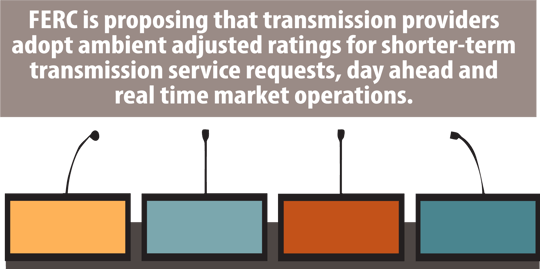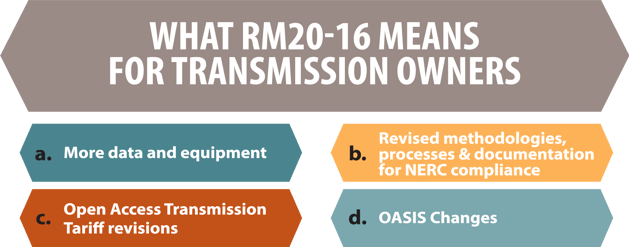- Home
- Services
- Hi-Line Engineering
- About
- Careers
- Contact
- Requests For Proposals
Whose Line Rating Is It Anyway? FERC Enters the Line Rating Discussion
by GDS Associates, Inc | December 15, 2020 | News , Newsletter - TransActions , Transmission
 On November 19th, the Federal Energy Regulatory Commission (FERC) issued a Notice of Proposed Rulemaking (NOPR) in Docket No. RM20-16-000 to reform the pro forma Open Access Transmission Tariff and its own regulations under the Federal Power Act to improve the accuracy and transparency of transmission line ratings.1 For the first time, FERC is proposing that transmission providers adopt ambient adjusted ratings for shorter-term transmission service requests, day ahead and real time market operations. The NOPR was issued following the Commission’s August 2019 staff whitepaper and September 2019 technical conference in Docket No. AD19-15-000.
On November 19th, the Federal Energy Regulatory Commission (FERC) issued a Notice of Proposed Rulemaking (NOPR) in Docket No. RM20-16-000 to reform the pro forma Open Access Transmission Tariff and its own regulations under the Federal Power Act to improve the accuracy and transparency of transmission line ratings.1 For the first time, FERC is proposing that transmission providers adopt ambient adjusted ratings for shorter-term transmission service requests, day ahead and real time market operations. The NOPR was issued following the Commission’s August 2019 staff whitepaper and September 2019 technical conference in Docket No. AD19-15-000.
These are the key elements of FERC’s NOPR:
 All transmission providers must use Ambient Adjusted Ratings (AARs) (1) as the basis for evaluation of transmission service requests that will end within 10 days (start to finish) of the request and (2) as the basis for determining the necessity of certain curtailment, interruption, or redispatch of transmission service that is anticipated to occur within those 10 days, including posting of available transfer capability (“ATC”) or other information on OASIS.
All transmission providers must use Ambient Adjusted Ratings (AARs) (1) as the basis for evaluation of transmission service requests that will end within 10 days (start to finish) of the request and (2) as the basis for determining the necessity of certain curtailment, interruption, or redispatch of transmission service that is anticipated to occur within those 10 days, including posting of available transfer capability (“ATC”) or other information on OASIS.
 All transmission providers must use Seasonal Line Ratings (1) as the basis for evaluating “longer-term” transmission service requests that will last longer than 10 days, including Network Transmission Service and (2) as the basis for determination of necessity of curtailment, interruption, or redispatch that is anticipated to occur more than ten days in the future, including posting of ATC or other information on OASIS.
All transmission providers must use Seasonal Line Ratings (1) as the basis for evaluating “longer-term” transmission service requests that will last longer than 10 days, including Network Transmission Service and (2) as the basis for determination of necessity of curtailment, interruption, or redispatch that is anticipated to occur more than ten days in the future, including posting of ATC or other information on OASIS.
 FERC is not proposing the use of Dynamic Line Ratings (DLRs) at this time. However, FERC is seeking comment: (1) on whether to require Regional Transmission Organizations (RTOs) and Independent System Operators (ISOs) to conduct a one-time study of the cost effectiveness of DLR implementation, and if so, what details and format that study should include and (2) on the additional costs, if any, needed to comply with the proposed requirement that RTOs/ISOs also be able to accommodate frequently updated transmission line ratings from transmission owners and (3) on whether there is any need to extend the requirement to accommodate frequently updated ratings to transmission providers that operate outside of an RTO/ISO.
FERC is not proposing the use of Dynamic Line Ratings (DLRs) at this time. However, FERC is seeking comment: (1) on whether to require Regional Transmission Organizations (RTOs) and Independent System Operators (ISOs) to conduct a one-time study of the cost effectiveness of DLR implementation, and if so, what details and format that study should include and (2) on the additional costs, if any, needed to comply with the proposed requirement that RTOs/ISOs also be able to accommodate frequently updated transmission line ratings from transmission owners and (3) on whether there is any need to extend the requirement to accommodate frequently updated ratings to transmission providers that operate outside of an RTO/ISO.
 FERC is also seeking comment on whether to require transmission providers to implement unique Emergency Ratings that would be used during post-contingency operations.
FERC is also seeking comment on whether to require transmission providers to implement unique Emergency Ratings that would be used during post-contingency operations.
 RTOs and ISOs will be required to establish and implement the systems and procedures necessary to allow transmission owners to electronically update transmission line ratings at least hourly. RTOs/ISOs must revise their dispatch and unit commitment models to implement AARs for both day ahead and real time markets and any intra-day reliability unit commitment or reliability assessment commitments. For day ahead markets, systems must have at least hourly capability for utilizing AARs.
RTOs and ISOs will be required to establish and implement the systems and procedures necessary to allow transmission owners to electronically update transmission line ratings at least hourly. RTOs/ISOs must revise their dispatch and unit commitment models to implement AARs for both day ahead and real time markets and any intra-day reliability unit commitment or reliability assessment commitments. For day ahead markets, systems must have at least hourly capability for utilizing AARs.
 Transmission owners must share transmission line ratings and transmission line rating methodologies with their respective transmission provider(s) and, in RTOs/ISOs, with their respective market monitor(s). FERC is also seeking comment (1) on whether to require transmission owners to share their ratings and ratings methodologies with other transmission providers upon request and (2) on whether to require transmission owners to make their transmission line ratings and rating methodologies available to other interested stakeholders, including posting information on their OASIS pages or other password protected online forum.
Transmission owners must share transmission line ratings and transmission line rating methodologies with their respective transmission provider(s) and, in RTOs/ISOs, with their respective market monitor(s). FERC is also seeking comment (1) on whether to require transmission owners to share their ratings and ratings methodologies with other transmission providers upon request and (2) on whether to require transmission owners to make their transmission line ratings and rating methodologies available to other interested stakeholders, including posting information on their OASIS pages or other password protected online forum.
RELEVANT TIMELINE
FERC is requesting comment on the proposed rule within 60 days after publication in the Federal Register (yet to occur as of this writing) and is proposing a staggered implementation for the ratings components of the rule. For historically congested transmission lines, AARs must be implemented within one year from the time that a compliance filing is made by the transmission provider with all other lines requiring AARs or seasonal line ratings.
Based on recent rulemakings at FERC, it is possible a final rule could take effect around Q1 2022. That would require that AARs be implemented for historically congested transmission lines in Q1 2023 with all other lines in Q1 2024.

WHAT RM20-16 MEANS FOR TRANSMISSION OWNERS
More data and equipment. In order to comply with requirements for AAR or DLR calculations, additional data on ambient temperature, humidity, wind speed, wind direction and other factors will need to be captured in real-time. This will include field equipment, more granular weather/wind forecasting and modifications to SCADA to provide real time ratings for state estimation and ATC calculations. Additional training will also be needed for system operators and operations support staff to ensure AARs are properly monitored in real-time and accounted for in short-term planning studies.
Revised methodologies, processes and documentation for NERC compliance. New rating methodologies need to be documented to ensure compliance with regional and NERC facility rating standards and FERC guidance from the NOPR. New processes will need to be developed for AAR and DLR calculations. Other affected documents will include the Capacity Benefit Margin Implementation Document (CBMID) and Transmission Reliability Margin Implementation Document (TRMID). On the operations front, calculation of IROLs/SOLs will need to be reviewed and adjusted as necessary.
 Open Access Transmission Tariff revisions. Changes to line ratings inevitably impact the calculation of Available Transmission Capacity/Available Flowgate Capacity (ATC/AFC). The methodology for ATC/CBM/TRM calculation needs to be revised to reflect changes made to the ATCID, CBMID and TRMID. These changes may also lead to changes to short-term and secondary non-firm transmission service.
Open Access Transmission Tariff revisions. Changes to line ratings inevitably impact the calculation of Available Transmission Capacity/Available Flowgate Capacity (ATC/AFC). The methodology for ATC/CBM/TRM calculation needs to be revised to reflect changes made to the ATCID, CBMID and TRMID. These changes may also lead to changes to short-term and secondary non-firm transmission service.
OASIS Changes. Depending on the method of automation used in the calculation and posting of ATC, software enhancements for real-time calculation tools, algebraic decrementing of ATC based on confirmed service, incorporating real-time transmission modeling for ATC values all need to be implemented.
WHAT NOW?
GDS recommends the following steps to be ready for the line rating NOPR and its eventual implementation:
Be Engaged. Change is coming. Stay abreast of the FERC NOPR and subsequent technical conferences. Get with your consultant and FERC counsel to let your voice be heard. Participate in various associations such as APPA and NRECA.
Be Prepared. Start doing your research now to look at tools and equipment you might need to implement the NOPR. Begin assessing your documentation and processes such as your Facility Rating Methodology, ATCID, CBMID, TRMID, TPL practices and IROL/SOL methodology. Leverage the expertise of your consultants to assist in the transition.
Be Communicating. Talk to your SCADA and OASIS vendors to help guide them by communicating what you need. Initiate the conversation with your utility neighbors to discuss how to best coordinate ratings on shared facilities.
Leverage GDS. Let us help you evaluate your organization’s readiness and develop a workplan for closing any gaps.
For more information or to comment on this article, please contact:
 Paul Kelly, Managing Director | CONTACT
Paul Kelly, Managing Director | CONTACT
GDS Associates, Inc. – Marietta, GA
770-799-2359 or paul.kelly@gdsassociates.com
 John Chiles, Principal | CONTACT
John Chiles, Principal | CONTACT
GDS Associates, Inc. – Marietta, GA
770-799-2423 or john.chiles@gdsassociates.com
GET OUR NEWSLETTER
RECENT POSTS
- Why MOD-026-2 Matters: Raising the Bar for Generator and IBR Modeling Reliability
- Exploring the 2026-2028 Reliability Standards Development Plan
- Blackstart Resource Availability During Extreme Cold Weather Conditions
- DOE Pushes FERC to Accelerate Large Load Grid Access
- Building a Cyber-Aware Workforce in the Utility Sector
Archives
- December 2015 (8)
- June 2025 (7)
- January 2016 (6)
- July 2016 (6)
- March 2021 (6)
- May 2022 (6)
- August 2020 (5)
- March 2015 (4)
- January 2019 (4)
- June 2019 (4)
- August 2019 (4)
- February 2020 (4)
- May 2020 (4)
- June 2020 (4)
- December 2020 (4)
- July 2021 (4)
- October 2021 (4)
- April 2024 (4)
- December 2024 (4)
- May 2025 (4)
- April 2015 (3)
- August 2016 (3)
- February 2017 (3)
- July 2017 (3)
- February 2018 (3)
- February 2019 (3)
- November 2019 (3)
- March 2020 (3)
- April 2020 (3)
- September 2021 (3)
- December 2021 (3)
- August 2022 (3)
- December 2022 (3)
- April 2023 (3)
- July 2023 (3)
- December 2023 (3)
- September 2024 (3)
- October 2025 (3)
- December 2025 (3)
- May 2014 (2)
- February 2016 (2)
- March 2016 (2)
- September 2016 (2)
- November 2016 (2)
- January 2017 (2)
- July 2018 (2)
- November 2018 (2)
- March 2019 (2)
- May 2019 (2)
- July 2020 (2)
- September 2020 (2)
- April 2021 (2)
- August 2021 (2)
- October 2024 (2)
- September 2025 (2)
- February 2014 (1)
- April 2014 (1)
- July 2014 (1)
- August 2014 (1)
- November 2014 (1)
- February 2015 (1)
- May 2015 (1)
- June 2015 (1)
- November 2015 (1)
- October 2016 (1)
- December 2016 (1)
- October 2018 (1)
- December 2018 (1)
- April 2019 (1)
- July 2019 (1)
- September 2019 (1)
- October 2020 (1)
- November 2020 (1)
- February 2021 (1)
- April 2022 (1)
- July 2022 (1)
- October 2022 (1)
- August 2023 (1)
- October 2023 (1)
- July 2025 (1)
- November 2025 (1)
Categories
- Newsletter - TransActions (85)
- News (78)
- Employee Spotlight (35)
- Energy Use & Efficiency (28)
- Energy, Reliability, and Security (17)
- Other Specialized Services (11)
- Environment & Safety (10)
- Power Supply (8)
- Transmission (8)
- NERC (7)
- Utility Rates (7)
- Cyber Security (5)
- Energy Supply (4)
- Hi-Line: Utility Distribution Services (4)
- Battery Energy Storage (3)
- Uncategorized (2)
- Agriculture (1)
- Hi-Line: Seminars & Testing (1)